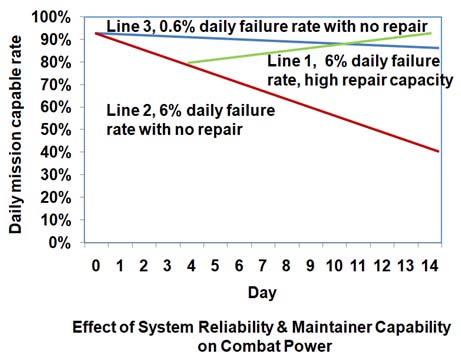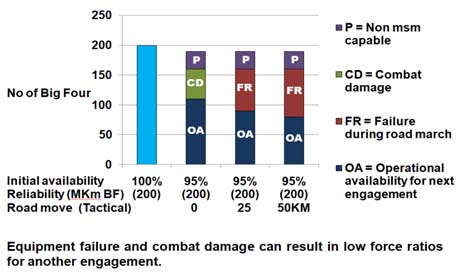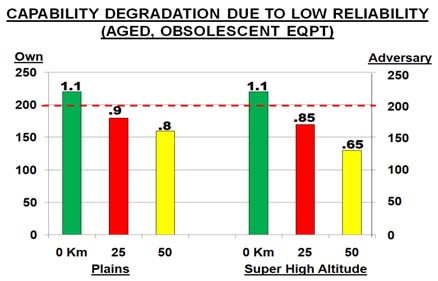“In the 21st century, leaders who lack sufficient technical know – how, function at a marked disadvantage. An officer or a soldier who feels insecure about even a small portion of his weapon, will not be able to meet with the rapidly changing conditions of modern day combat. An Army that feels it possesses the complete ability to design, maintain and adapt its weapons, has a new sense of self-confidence. The rapid and complete repair of weapons, the innovative employment of devices, the close association between the maintainer, the commander and the soldier, all lead to this desired effect.”
Equipment Readiness (ER) requires a series of actions intended to organise equipment capabilities to achieve objectives and accomplish missions. It is the only way of achieving mass, the controlling principle of war. The depth and duration of operations is often dependent on the extent of ER. In an Army where a logistics view of engineering support prevails, where Equipment Management (EM) rather than ER sometimes gets a passing reference, it is difficult to understand this vital connection between engineering and operations. It needs to be noted that supply and transportation functions of logistics do not require similar skills and resources as needed to keep equipment mission capable and hence a different approach is needed to tackle ER issues. In the Israeli Army, operational doctrine which represents an assemblage of thoughts expressing an approach to warfighting, equipment capability requirements are considered exclusively. Engineering support helps extract such capabilities from weapon systems. The two are fused into an inseparable bond that allows superior force ratios and hence decisive actions. In the Yom Kippur war, the Israel Defence Forces offset its numerical disadvantages and lack of strategic depth by capitalising on qualitative strengths such as excellence in maintenance.
The two significant measures of an Army’s equipment readiness are operational availability and mission reliability. The former signifies the availability of combat equipment in a mission-capable state at the start of any operation and the latter denotes the battle endurance of that equipment over the duration of the mission. While operational planners may be aware of these terms, not many understand the impact of these parameters on the final outcome of combat missions. Now that the Indian Army is facing a stand-off in Ladakh and complex systems such as tanks, guns, missiles have been deployed, hopefully some focus will get restored on conventional readiness needed to match the People’s Liberation Army (PLA).
It is imperative that there is clear understanding of the linkages between combat capability, operational availability and reliability so that formations remain strong and fast enough to strike hard. It is generally said that a combat force is only as capable as its weakest link. Merely by inducting a new artillery system, a combat vehicle or an assault rifle, the combat force cannot be expected to transform into an invincible entity. What is needed is to fully understand how current availability and reliability rates are affecting equipment capabilities and how capability gaps result due to the deployment, storage and utilisation of systems as well as how they age – normally at the rate of four to five percent per annum.
Equipment Capability (EC), at times also referred to as start of mission availability and during mission reliability, is always misconstrued as garage availability in the Indian Army. There is hardly any discussion beyond the numbers – a reflection of the EM and logistics mindset. Even if initial availability is high, say 90 percent, it will denude post commencement of operations due to enemy action or system failures and could impact mission outcomes. To enhance mission availability, either equipment replacements should be readily available or adequate maintainer capacity available at site. The figure below explains the same. With low failure rates say 0.6 percent per day, the operational availability remains above 80 percent – an accepted metric for combat effectiveness. However, if failure rates shoot up due to prolonged use, vintage systems or enemy action, as happened in Kargil, operational availability falls drastically within the first few days of operations, rendering the unit unfit for combat. An effective close engineering support capability can help shore up equipment availability as was achieved by Israelis during the Yom Kippur war wherein of the 840 damaged tanks more than half were recovered, repaired and recommitted. During the Kargil war, the aged Bofors guns continued to rain fire and fury facilitated by close engineering support.

Fig. 1
Rather than state-of-the-art weaponry and specifications of the platforms, it is the quality of crew, technical prowess of the maintainers and innovative skills in employment that matter more on the battlefield. In High Altitude Areas (HAA) extreme weather conditions, ubiquitous moisture and grit of mountains can wear down the most hardened systems, besides taking a heavy toll on engines. One year of deployment in HAA is equivalent to five to six years of deployment in plains and deserts. It is here that weapons design, maintenance practices and operating skills and cultural predisposition can become the decisive factors. If operators lack equipment familiarity and have a habit of looking back, it could dampen initiatives and survivability. Superior maintenance skills of the Israelis resulted in recovery and creation of a pool of over 300 Egyptian tanks which were then employed against them during the war.
During the Yom Kippur war, maintenance capability distinctly influenced the overall approach to planning during the preparatory and planning stages of the war and in the midst of actual hostilities. Sadly, in the Indian Army, ER seldom gets considered in the planning process and is more often than not, casually consigned to the realm of “neither tactics nor strategy”. The Egyptian Armed forces viewed Soviet tanks as far from optimised for desert use and were not satisfied with the relatively high crash rate of Soviet-made aircraft over Egypt in 1971 and 1972. Ten days into the war, nearly 80 percent of the tank fleet was down. In the Indian context, there are equipment capability gaps. The tanks were designed as per Soviet tactical and operational thoughts for the race to the Rhine, not for Indian conditions, that too super HAA. Severe equipment failures could be expected and the Indian Army needs to be forearmed to address it.
Another issue of concern is the declining operator skills which get honed with a near-fanatical focus on training and rehearsals. Going back to the Yom Kippur war, “tank-hunting teams” of infantry honed gunnery skills with Sagger wire-guided anti-tank missiles, firing up to 25 missiles per day on special ranges. In addition, dissemination of explicit, detailed instructions enabled soldiers to acquire specific skills that would be required of them during the anticipated operations. One skill recommended is the ability of weapon crew to address category one and two stoppages on their own without looking back for specialist technicians.
Moving forward, let us examine how equipment capability gaps can affect combat performance and potentially create a high level of risk. Let us take a case of Big Four systems – three tracked vehicles and a gun system say around 200 numbers of a fighting force. Assuming that garage availabilities at start are near 100 percent, let us assume a mission entailing tactical moves (hours run) of 0, 25 and 50 odd kilometres uphill in super high altitudes; move taking place in low gears under combat conditions. A fair number of combat vehicle failures can be expected during the road march as these tanks, Infantry Combat Vehicles (ICVs) and prime movers were not designed with such a duty cycle in mind. This will reduce the number of combat vehicles available for any engagement later. Longer the march, higher will be the failures. During the ensuing engagement, some combat vehicles may fail, some may be destroyed by enemy action, reducing the active systems available for the second day.
In super high altitudes, weather and terrain will be a constraint in detection and firing at the enemy and hence distance between the target and the shooter will reduce, increasing risks. Similarly, the availability of guns and other soldier systems such as MMGs, LMGs and mortars, could reduce. In simulations carried out by the US Army, over a 100-km road march, about 60 vehicles suffered failures; 30 were destroyed during the engagement and two failed mechanically during combat, reducing the availability by a whopping 50 percent. Figure below sums up the likely end of the state of the Big Four. The operational availability could fall below 100 drastically reducing force ratios to .65 or lower, adversely impacting mission outcomes. Superior repair and recovery skills can shore up force ratios and address the adversary’s quantitative advantage.

Fig. 2 Categories of Equipment Failure and Combat Damage
It can be seen that the availability of the Big Four grossly reduces as the distance and duration of tactical moves, increases, denuding force ratios well below acceptable limits. This is called the diminishing effect of distance and terrain. The degradation is more in the mountains than in the plains. This could impact mission outcomes by severely degrading staying power of the Infantry on icy slopes. High quality engineering support can recycle back failed and damaged equipment and overall availabilities scaled up. Operational commanders have to view damaged equipment as soon–to–be–repaired assets rather than wash-outs. With such a thought at the top, maintainers can leverage their technical familiarity with platforms and systems to employ them in more innovative ways.

Fig. 3 Comparison of Capability Degradation
Analysts Anthony H Cordesman and Abraham R Wagner in their technical study of the 1973 war, concluded that ‘repaired tanks formed an important element of combat strength’ and that this particular metric overwhelmingly favoured the Israelis. Bren Adan, an Israeli Division Commander, frequently refers to the high quality repair and recovery operations planned by the Israelis in his chronicle of the Sinai campaign.
A measure of EC for small arms, tracks, guns and radars can be fixed using generalised Lanchester’s equation, nature of missions planned and maintenance actions initiated to plug EC gaps. The PLA is known to have worked elaborately on EC, which is reflected in the type of weapon systems deployed at the Line of Actual Control (LAC). It is critical that the Indian Army takes a deeper look into EC-linked interventions of its legacy systems and considers the following:
The desire to transform the force at the time it is addressing a two-front war needs to be realistically balanced with available resources. The Indian Army needs to look at a mix of traditional and future combat systems till the middle of this century
It needs to be remembered that funds put in new tanks, guns and AD systems will limit its availability for soldier systems, Special Forces, cyber, space, aviation and mobile satellite communications. Instead EC enhancements could provide the answer. M1 Abrams, Bradley, Stryker are to be retained beyond 2050 by the US Army through technology insertion.
-
- Big gains in war fighting effectiveness can be obtained by introducing new technologies into existing hardware, especially those that bolster agility, connectivity and situational effectiveness.
- The Indian Army should stop delaying comprehensive upgrade cum resuscitation of its legacy systems at Army Base workshops and seek additional funding to recapitalise its stressed-out assets. A fully revitalised, reliable force is essential to address the developing threats in mountains.
- Undertake a capability-centric modernisation maximizing use of new technologies with the aim of transforming into a truly agile and aware force, centered on force self-sufficiency and smaller footprint.
Conclusion
In conclusion, I wish to reiterate that an integrated view of operational readiness is essential to develop enduring combat capabilities. Equipment Readiness cannot be considered as an afterthought in the planning process. Instead, it has to be the pillar around which operational plans get configured. The fighting force needs to know how far or how long it can run or jump. This will only be feasible if people with foundational knowledge are put at the helms. It is tragic that those who need to study more about the enemy and innovate new ways of defeating him, are busy studying Peter Drucker, not Clausewitz and Sun Tzu.
A new kernel of operational doctrine based on technology, needs to be scripted against the PLA. Operational readiness can be scaled up, only if like the Indian Air Force and the Indian Navy, the Indian Army too provides its maintainers the support and engineering stability to carry out equipment capability regeneration of its obsolescent inventory. Sophisticated electronic and missile systems demand high grade technical skills. With such unprecedented deployment at the LAC, the least the gallant Indian soldiers would expect is that weapons deployed in his support, possess the reliability to function without stoppages till the last round. It may be worthwhile to revisit history and minutely re-examine all events preceding the famous Battle of Rezang La in 1962. Some interesting lessons could emerge.
In their seminal work, PLA’s Science of Military Strategy, the importance of engineering support in modern day combat has been reinforced. It has been explained that combat damage rate of modern weapons has increased significantly as the causes of damage have changed from hard kills to hard and soft kills i.e. problems with hardware and software. Technical support has to address these on the battlefield and a high quality maintenance support will have a direct impact on consistent performance of weapon systems and a bearing on the success or failure of strategic operations. In the Chinese view, a combat environment characterised by advanced weaponry, heavy attrition and fast paced conflicts of short duration, demands unprecedented levels of technical skills. Their own analysis of the 1973 Arab Israeli war concluded, “The IDF`s ability to repair and return damaged weapons and equipment to the battlefield essentially changed the outcome of the campaign”.
References
- Taking a look under the Hood, Colonel J.H Powell, Land Warfare paper 128, Aug 2019.
- Army Equipment after Iraq, L J Korb, LB Thompson, CP Wadhams, Centre for American Progress, Apr 2006.





A very timely and important paper that covers a subject that is often neglected.